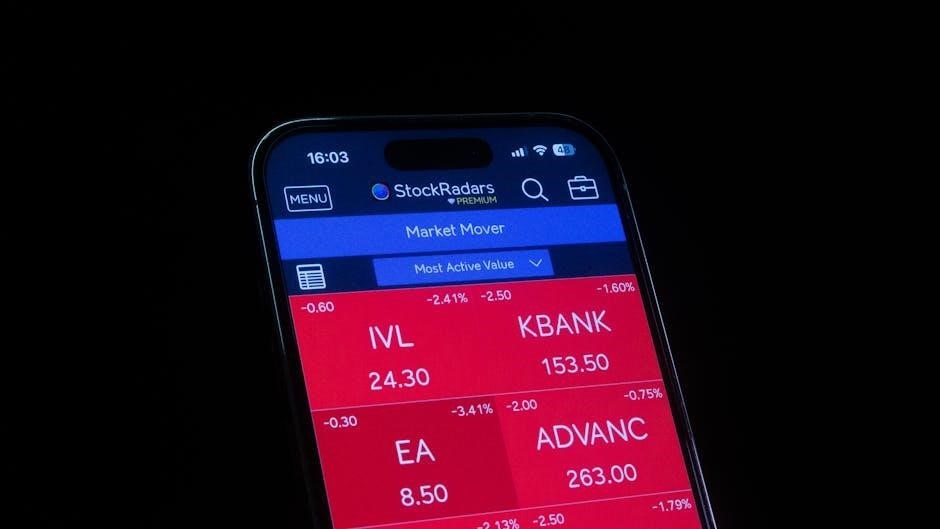
place value chart to millions pdf
A place value chart is a visual tool that helps students understand the value of digits in numbers, from units to millions. It organizes numbers into columns, showing how each digit represents tens, hundreds, thousands, and beyond. This chart is essential for building foundational math skills, as it makes abstract concepts tangible. By extending to millions, it prepares learners for complex calculations. PDF formats of these charts are widely used for easy sharing and classroom activities, enhancing visual learning and number composition understanding.
1.1 What is a Place Value Chart?
A place value chart is a visual tool used to represent the value of digits within numbers, helping students understand how each digit represents units, tens, hundreds, and beyond. It organizes numbers into columns, with each column representing a specific place value, such as ones, tens, hundreds, thousands, and millions. This chart is particularly useful for breaking down complex numbers into manageable parts, making it easier to perform arithmetic operations like addition and subtraction. By extending to millions, the chart prepares learners for higher-level math concepts and real-world applications. PDF formats of these charts are widely available, offering educators a convenient way to share and use them in classrooms, enhancing visual learning and number composition understanding. Its clear structure supports both basic and advanced place value skills, making it an essential resource for math education.
1.2 Evolution of Place Value Charts
Place value charts have evolved from basic visual aids to comprehensive tools that cover numbers up to millions. Initially, they focused on units, tens, and hundreds, but as math education advanced, charts expanded to include thousands, millions, and beyond. The development of digital tools like Google Sheets and PDF formats has made these charts more accessible and interactive. Educators now use place value charts to teach complex number composition and decomposition. The inclusion of millions in these charts reflects the growing need to prepare students for higher-level math. Over time, these charts have become integral to visual learning, bridging the gap between concrete and abstract number concepts. Their adaptability to digital platforms ensures they remain a vital resource for modern education.

1.3 Importance of Visual Learning in Math
Visual learning is a powerful approach in math education, especially when teaching place value concepts. Place value charts provide a clear, structured way to visualize numbers, making abstract ideas more tangible. By organizing numbers into columns representing units, tens, thousands, and millions, students can better understand the relationships between digits. This method enhances engagement and retention, as learners can see how numbers change and interact. Digital tools, such as Google Sheets and PDFs, further enhance this experience, allowing for interactive and shareable charts. Visual learning also supports diverse learning styles, ensuring that all students can grasp complex concepts like place value to millions. This approach fosters a deeper understanding of number composition and decomposition, which is essential for higher-level math skills.

Understanding Place Value Basics
Place value charts simplify number understanding, from units to millions, by visually organizing digits into columns. This structure helps learners recognize the value of each digit’s position in a number.
2.1 Units, Tens, and Hundreds
Understanding place value begins with recognizing units, tens, and hundreds. A place value chart organizes numbers into columns, with units on the far right. Each position represents a value: units (1s), tens (10s), and hundreds (100s). For example, in the number 456, “6” is in the units place, “5” in the tens, and “4” in the hundreds. This visual structure helps learners grasp how numbers are composed and how digits relate to each other. By extending the chart to millions, students can see how values progress and understand the concept of renaming numbers as they move from one place to another.
2.2 Thousands, Millions, and Beyond
Expanding place value understanding beyond hundreds introduces thousands, millions, and larger units. Each position represents a value multiplied by 10, with thousands (1,000) and millions (1,000,000) extending the chart. For example, in 1,234,567, “1” is in the millions place, “2” in the hundred thousands, and so on. This structure helps learners visualize how numbers grow exponentially. By using a place value chart to millions, students can easily rename and decompose numbers, such as understanding 1,000 as “1 ten hundred” or 1,000,000 as “1 million.” This foundational skill is crucial for advanced math operations and real-world applications, where large numbers are common. PDF charts are particularly useful for clear visualization and sharing in educational settings.
2.3 Renaming Numbers in Different Places
Renaming numbers in different places involves breaking them down into their place values, such as renaming 45 as 40 + 5 or 3,000 as 3 thousands. This skill is crucial for understanding how numbers can be decomposed and recomposed for operations like addition and subtraction. Using a place value chart to millions, students can visually see how numbers like 1,250,000 can be renamed as 1 million, 200 thousands, 50 thousands, and 0 units. This process enhances number sense and prepares learners for complex math operations. PDF charts provide a clear and organized way to practice renaming, making it easier for students to grasp these concepts and apply them in real-world scenarios. This foundational skill is essential for math fluency and problem-solving.

How to Read a Place Value Chart
A place value chart to millions guides learners to interpret numbers by moving from right to left, increasing in value from units to millions, visually organizing digits for clarity and understanding.
3.1 Basic Structure of the Chart
The basic structure of a place value chart to millions pdf is organized into columns representing units, tens, hundreds, thousands, and millions. Each column is labeled clearly to indicate its place value, helping students understand the positional significance of each digit. The chart typically starts from the rightmost column as units and progresses to the left, with each subsequent column representing a higher place value. This hierarchical arrangement allows learners to visually track how numbers increase in magnitude. The use of PDF format ensures that the chart is easily shareable and maintains a consistent layout, making it a practical tool for both classroom and individual use. By structuring the chart this way, it becomes an intuitive guide for decomposing and composing numbers up to millions.
3.2 Moving from Right to Left
Moving from right to left on a place value chart to millions pdf represents the progression from smaller to larger place values. Starting with units on the far right, each subsequent column to the left represents tens, hundreds, thousands, and eventually millions. This right-to-left movement helps learners visualize how numbers grow in magnitude as they advance through place values. For example, when counting up, 10 units (ones) are renamed as 1 ten, and this pattern continues seamlessly up to millions. This hierarchical structure is consistent in PDF charts, making it easier for students to understand and apply place value concepts in various math operations, such as addition and subtraction. The clear visual flow enhances the learning process, ensuring a solid grasp of number composition and decomposition.
3.3 Practical Examples of Number Representation
A place value chart to millions pdf provides clear examples of how numbers are represented. For instance, the number 1,234,567 is broken down into 1 million, 2 hundred thousands, 3 ten thousands, 4 thousands, 5 hundreds, 6 tens, and 7 units. This hierarchical structure helps learners visualize each digit’s value. By using the chart, students can see how numbers like 456,789 are composed of 4 hundreds thousands, 5 ten thousands, 6 thousands, 7 hundreds, 8 tens, and 9 units. Such examples make it easier to understand how place values build upon one another, from units up to millions. This practical approach ensures a deep understanding of number composition and prepares learners for more complex math operations.

Creating a Custom Place Value Chart
Creating a custom place value chart to millions involves defining the range, adding columns for each place value, and highlighting the millions place for clarity. Digital tools like Google Sheets can help design interactive charts, while PDFs ensure easy sharing and printing for classroom use. This approach allows educators to tailor charts to specific learning needs, ensuring students grasp the concept of place value up to millions effectively.
4.1 Steps to Design a Chart to Millions
Designing a place value chart to millions involves several structured steps. First, identify the range from units to millions. Next, create columns for each place value: Units, Tens, Hundreds, Thousands, and Millions. Label each column clearly. Use distinct colors or shading to differentiate each place, improving visual clarity. Include markers or separators between columns to avoid confusion. Finally, test the chart with sample numbers to ensure accuracy. Tools like Google Sheets can automate this process, while PDF formats allow for easy sharing and printing. This method ensures the chart is both functional and visually appealing for educational purposes. Consistency is key to effective learning.
4.2 Including the Millions Place
Incorporating the millions place into a place value chart expands its utility for advanced number representation. Begin by adding a new column to the right of the thousands place, labeled “Millions.” This column represents numbers from 1,000,000 upward. Ensure the chart aligns with smaller units, maintaining consistency in structure. Use distinct colors or shading to highlight the millions place, making it visually distinct. For example, the number 3,456,789 would show 3 in the millions column, 4 in the hundreds of thousands, and so on. This extension helps learners grasp larger numerical values. Tools like Google Sheets can be used to create such charts, and PDF formats ensure easy distribution and use in educational settings.
4.3 Tips for Making It Visually Clear
To ensure clarity, use distinct colors or shading for each place value, such as blue for units, green for tens, and red for millions. Maintain consistent column widths and spacing, with clear headings for each place. When creating a PDF, ensure the chart fits on a single page without overflow. Use bold fonts for headings and avoid clutter by separating each column clearly. Tools like Google Sheets or design software can help in organizing the layout. Testing the chart with a sample number, such as 5,432,109, ensures that each digit aligns correctly under its respective place value. This visual structure aids in teaching and reinforces the understanding of number composition up to millions.

Using the Chart for Math Operations
Place value charts simplify addition, subtraction, multiplication, and division by visually organizing numbers. They help students align digits correctly, especially when working with large numbers up to millions.
5.1 Addition and Subtraction with Place Value
Place value charts are invaluable for teaching addition and subtraction, especially with numbers up to millions. By breaking down numbers into units, tens, hundreds, and thousands, students can align digits correctly, ensuring accurate calculations. The chart’s structure helps visualize how numbers increase or decrease, making it easier to regroup or rename values during operations. For instance, adding 1,234,567 and 890,123 becomes manageable by aligning each digit under its respective place value. This method reduces errors and builds a strong foundation for more complex math. The chart’s clarity also supports understanding of borrowing and carrying over, essential skills for mastering arithmetic.
5.2 Multiplication and Division Concepts
Place value charts are instrumental in teaching multiplication and division, especially with large numbers up to millions. They help students visualize how digits interact during these operations. For multiplication, the chart illustrates how multiplying by powers of 10 shifts place values, simplifying calculations like 123,456 × 10. Division concepts, such as splitting numbers into equal parts, become clearer when using the chart to align digits and manage remainders. This visual approach reduces errors and enhances understanding of how numbers scale during multiplication and divide evenly during division. It provides a structured method for managing complex operations, fostering confidence in working with multi-digit numbers and higher place values.
5.3 Real-World Applications of Place Value
Place value charts are invaluable in real-world scenarios, from budgeting to engineering. Architects use place value to calculate materials for large-scale projects, ensuring accuracy in cost estimates. In finance, understanding place value aids in tracking expenses, managing investments, and preparing tax documents. Retailers rely on place value to set prices, calculate discounts, and optimize inventory. Even in everyday tasks, such as measuring ingredients for cooking or planning events, place value helps in organizing quantities efficiently. These applications highlight how mastering place value charts equips individuals to handle practical challenges with precision, making math a powerful tool for real-life decision-making and problem-solving across various industries and activities.

Digital Tools for Place Value Learning
Digital tools like Google Sheets enable interactive place value charts, while PDFs allow easy sharing of visual aids for millions place learning, enhancing classroom engagement and accessibility.
6.1 Google Sheets for Interactive Charts
Google Sheets is a powerful tool for creating interactive place value charts, allowing users to dynamically explore number composition up to millions. Its versatile Query function enables data manipulation, making it ideal for place value exercises. Educators can design templates where students drag digits into place, enhancing understanding of units, tens, and millions. Real-time collaboration and automatic calculations simplify learning complex place value concepts. Sheets can also generate PDFs for easy sharing, ensuring accessibility for classroom activities focused on millions place learning. This digital approach makes place value visualization engaging and efficient, catering to diverse learning needs and promoting interactive math education.
6.2 Generating PDFs for Easy Sharing

6.3 Free Online Templates and Resources
Free online templates and resources for place value charts are widely available, offering educators and students versatile tools. Google Sheets provides interactive templates that can be customized to include millions place values. Websites like Teachers Pay Teachers and educational forums offer downloadable PDF charts designed for classroom use. These resources often include pre-designed layouts, making it easy to print or share digitally. Tools like Canva also allow users to create visually appealing charts tailored to specific learning needs. Additionally, many educational platforms provide place value chart generators, enabling quick creation of charts up to millions. These resources support teachers in delivering engaging math lessons and help students grasp complex place value concepts effectively.

Classroom Activities with Place Value Charts
Engage students with group projects, interactive tasks, and collaborative problem-solving using place value charts. These activities promote teamwork, critical thinking, and practical application of number concepts.
7.1 Pair Work and Group Exercises
Pair work and group exercises with place value charts foster collaborative learning and critical thinking. Students can work together to identify and rename numbers, enhancing their understanding of place value concepts. These activities encourage teamwork, communication, and problem-solving skills. For example, pairs can match numbers to their place value representations or solve math problems using the chart as a guide. Group exercises, such as creating number stories or comparing values, deepen comprehension. Using charts up to millions ensures students grasp larger units and their relationships; Such interactive tasks make learning engaging and help students apply place value knowledge in real-world scenarios, preparing them for advanced math operations.
7.2 Games to Reinforce Learning
Games are an effective way to reinforce place value concepts, making learning interactive and fun. Activities like “Place Value Bingo” or “Move and Match” encourage students to identify and arrange numbers according to their place values. Digital apps and online tools offer engaging games where students can practice number composition and decomposition. Board games or card games that involve moving tokens across a place value chart can also enhance understanding. These games help students visualize how numbers change as they move from units to millions, fostering a deeper grasp of mathematical relationships and preparing them for more complex operations in higher math.
7.3 Assessing Understanding Through Quizzes
Quizzes are an excellent way to assess students’ grasp of place value concepts, ensuring they understand how numbers are structured up to millions. PDF-based quizzes offer a practical format for testing, as they can be easily distributed and completed. These assessments often include multiple-choice questions, fill-in-the-blank exercises, and number decomposition tasks. For instance, students might identify the value of specific digits in a number or rename numbers in different places. Quizzes also help teachers identify learning gaps, allowing for targeted interventions. Regular assessments using place value charts to millions PDFs ensure students are well-prepared for more advanced math operations and real-world applications, reinforcing their foundational skills effectively.

Advanced Topics in Place Value
Exploring beyond millions, advanced place value concepts involve larger units like billions and trillions. These higher place values build on foundational understanding, preparing learners for complex math operations and real-world financial applications.
8.1 Understanding Larger Units Beyond Millions
Exploring place values beyond millions introduces learners to billions, trillions, and beyond. These larger units are essential for understanding vast quantities in finance, science, and real-world data. Using a place value chart extended to millions and beyond helps visualize how each digit’s value increases exponentially. For instance, a billion is a thousand millions, and a trillion is a thousand billions. This understanding is crucial for advanced math operations and interpreting large datasets. PDF charts are particularly useful for clearly presenting these vast scales, making complex concepts more accessible and engaging for students.
8.2 Decimal Places and Their Relationship to Whole Numbers
Understanding the relationship between decimal places and whole numbers is crucial for grasping place value comprehensively. Each decimal place represents a fraction of a whole number, with the tenths place being one-tenth, the hundredths place one-hundredth, and so on. A place value chart extending to millions and including decimals visually connects whole numbers to their fractional counterparts, illustrating that decimals are continuations of the same place value system. For example, 0.1 is one-tenth of 1, aligning with the units place. This relationship is vital for operations like addition and subtraction, where decimals must be aligned with their corresponding whole number places. Using PDF charts, educators can clearly present this concept, aiding students in visualizing and understanding the seamless transition from whole numbers to decimals, enhancing their math proficiency. This visual connection supports learners in developing a robust foundation in number composition and decomposition, essential for advanced mathematical reasoning and problem-solving skills. By integrating decimal places into the place value framework, students gain a holistic understanding of numerical relationships, fostering accuracy in calculations and deeper mathematical insights. This comprehensive approach ensures that learners can apply place value knowledge across various mathematical contexts, from basic arithmetic to complex computations, making it an indispensable tool in math education.
8.3 Combining Place Value with Other Math Concepts
Place value charts are foundational tools that can be integrated with various math concepts to enhance learning. For instance, they can be used to teach multiplication and division by showing how numbers expand or contract. When combined with word problems, place value charts help students visualize and break down complex scenarios into manageable parts. Additionally, they can be paired with algebraic thinking to demonstrate how place value underpins equation solving. By connecting place value to real-world applications, educators can show how it is essential for budgeting, measurement, and financial literacy. Digital tools, such as Google Sheets and PDF templates, make it easier to create interactive charts that combine place value with other math concepts, fostering a deeper understanding and practical application of numerical relationships.
Place value charts are invaluable for building foundational math skills, offering clear visual representations of numerical relationships. Their scalability to millions and integration with digital tools like Google Sheets ensures they remain relevant for advanced learning and real-world problem-solving.
9.1 Summarizing Key Benefits of Place Value Charts
Place value charts offer numerous benefits, primarily enhancing visual learning and understanding of numerical relationships. They simplify complex concepts like units, tens, and millions, making them accessible to learners. By providing a structured format, these charts aid in decomposing and recomposing numbers, which is crucial for arithmetic operations. Their scalability to millions ensures relevance for advanced math, while digital tools like Google Sheets enable interactive and shareable PDFs. This versatility fosters engagement and supports diverse learning styles, making place value charts an indispensable resource for educators and students alike, promoting deeper math literacy and problem-solving skills across various age groups and skill levels.
9.2 Applying Place Value Knowledge in Higher Math
Mastering place value charts, especially to millions, lays a strong foundation for higher mathematics. Understanding how digits represent different values is crucial for algebra, where place value aids in solving equations and manipulating polynomials. In calculus, decomposing numbers enhances comprehension of rates of change and limits. The ability to break down large numbers also simplifies complex operations like multiplication and division of millions, making advanced math more accessible. Additionally, place value charts help in understanding decimal places and their relationship to whole numbers, which is essential for advanced arithmetic and real-world applications like budgeting or financial planning. This skill bridges fundamental math concepts to higher-level problem-solving, fostering lifelong math literacy and adaptability in various academic and professional scenarios.
9.3 Encouraging Lifelong Math Literacy
Place value charts to millions PDFs serve as a cornerstone for fostering lifelong math literacy by providing a clear, visual foundation for understanding numbers. These tools help learners of all ages grasp the relationships between digits and their place values, making abstract concepts tangible. By mastering place value, individuals develop a robust problem-solving mindset, enabling them to approach complex arithmetic and real-world challenges with confidence. This foundational knowledge also supports STEM careers and everyday tasks like budgeting or financial planning. As digital tools like Google Sheets and PDFs make these charts accessible, they ensure that math literacy remains a lifelong skill, empowering individuals to adapt to new mathematical demands throughout their lives.
Leave a Reply
You must be logged in to post a comment.